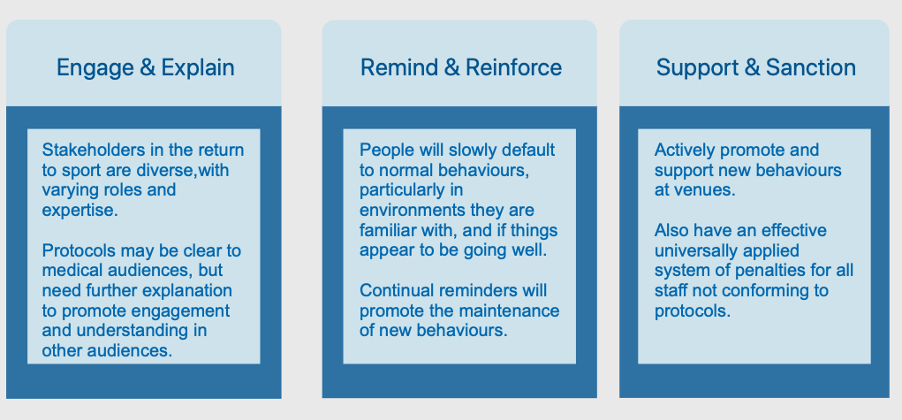Challenges and learnings from a non-testing approach returning to elite sport
On June 1st 2020, horseracing returned to elite competition. Horseracing was comparatively well placed to respond to some of COVID-19’s challenges given rigorous approaches to biosecurity following the outbreak of Equine Influenza in early 2019, halting racing temporarily. This, combined with ongoing infectious disease risks to human and equine participants, ensures that infectious diseases remain prominent on the sport’s risk register.
Decision to Resume
A recent BJSM blog highlighted that social distancing is more readily applied in some sports settings.1 Racing is predominantly outdoors and in regulated and often rural facilities, encouraging private transport for horses, staff, jockeys and attendees. These attributes supported the belief that a coordinated return to racing could pose little additional transmission threat to racing industry staff and the local population.
In collaboration with the Chief Medical Officers group,2 Public Health England nationally and locally, and Department for Culture, Media and Sport,3 elite competition ‘behind closed doors’ in England commenced on June 1st 2020. In collaboration with the equivalent bodies in Wales and Scotland, resumption followed on 15th and 22nd June, respectively.
Resumption of Racing Guidelines
A COVID-19 Racing Industry Steering Group was established (February 2020) to create a model for racing ‘behind closed doors’ and oversee the suspension and subsequent resumption of racing. A phased plan for the resumption and transition towards a normal fixture schedule was developed. On 1st May 2020, racecourses were invited to submit expressions of interest to stage fixtures and demonstrate how they would meet risk mitigation and infection control criteria, such as social distancing measures, hygiene control and capacity.
On May 23rd the British Horseracing Authority (BHA) published guidelines and operating procedures for racing behind closed doors.4 These protocols, and the wider resumption process, were aligned with Stage 3 of the DCMS guidelines, ‘Return to domestic competition,’3 and are a comprehensive phased return to racing (Figure 1).

Figure 1. Examples of guidelines for attendees, race day coordination, and limiting transmission risk, from the BHA’s Guidelines and Operating Procedures
The guidelines seek to ensure every named individual is aware of and adheres to practices to limit COVID-19 transmission, and that racing is able to risk-manage all race day elements. Breaches of regulations have resulted in informal warnings from Social Distancing Officers and, in some cases, removal from facilities.
All attendees at a racecourse, including BHA officials, trainers and medical and veterinary staff are required to complete an education module on social distancing, public hygiene and COVID-19 transmission. There is a screening process, which includes a questionnaire pre-departure to and health screening on arrival at the racecourse. On-arrival health screening includes a temperature assessment, completion of a symptom checklist, and questions on recent overseas travel and vulnerable status.
COVID-19 Surveillance in Racing (CoSR)
Alongside this, the COVID-19 Surveillance in Racing (CoSR) programme has been developed and implemented. Supported by the University of Bath, this programme seeks to monitor risks associated with COVID -19 in racing environments by:
- Assessing the COVID-19 rate in racecourse areas
- Assessing the COVID-19 rate in areas with training yards
- Asking individuals involved in any aspect of racing to report a positive test
The surveillance programme monitors COVID-19 rates in Lower Tier Local Authority Areas (LTLAs) of all GB racecourses with races in the following 14-days, with data reported twice weekly. The COVID-19 rate for yards is reported weekly. Two metrics are produced:
- The highest LTLAs (cases per 100,000 population)
- The LTLAs with the highest 7-day percentage increase in cases
This reporting ensures ongoing risk evaluation through stages of the pandemic, nationally and across GB. Where local or regional public health restrictions are implemented, racing-specific data is available to support discussions. This programme also enables the early identification of trends in specific geographic areas, and immediate awareness of yards and racecourses impacted, supporting conversations regarding their risk and infection control protocols.
Learnings
The past three months have been a learning experience across all sports settings, at all levels of participation and management. The following points capture some learnings from the resumption of horseracing, which may hold relevance for other settings:

Figure 2. Key learning points from the resumption of racing in Great Britain.
The information presented here describes our current, responsive and evolving approach to a risk managed return to elite competition, from which other recreational and elite sporting environments may benefit.
Authors and Affiliations
Madeleine Davies,1 Kerry Kuznik, 2 Keith Stokes,1, 3 Jerry Hill2
1University of Bath, 2British Horseracing Authority, 3Rugby Football Union
References:
- Carmody S, Murray A, Borodina M, Gouttebarge V, Massey A. When can professional sport recommence safely during the COVID-19 pandemic? Risk assessment and factors to consider. Br J Sports Med. 2020. doi:10.1136/bjsports-2020-102539
- Kemp S, Cowie CM, Gillett M, et al. Sports medicine leaders working with government and public health to plan a “return-to-sport” during the COVID-19 pandemic: the UK’s collaborative five-stage model for elite sport. Br J Sports Med. 2020. doi:10.1136/bjsports-2020-102834
- Elite sport – return to domestic competition guidance – GOV.UK.
- British Horseracing Authority Guidelines and Operating Procedures for Racing behind Closed Doors for All Attendees in Context of COVID-19.; 2020.